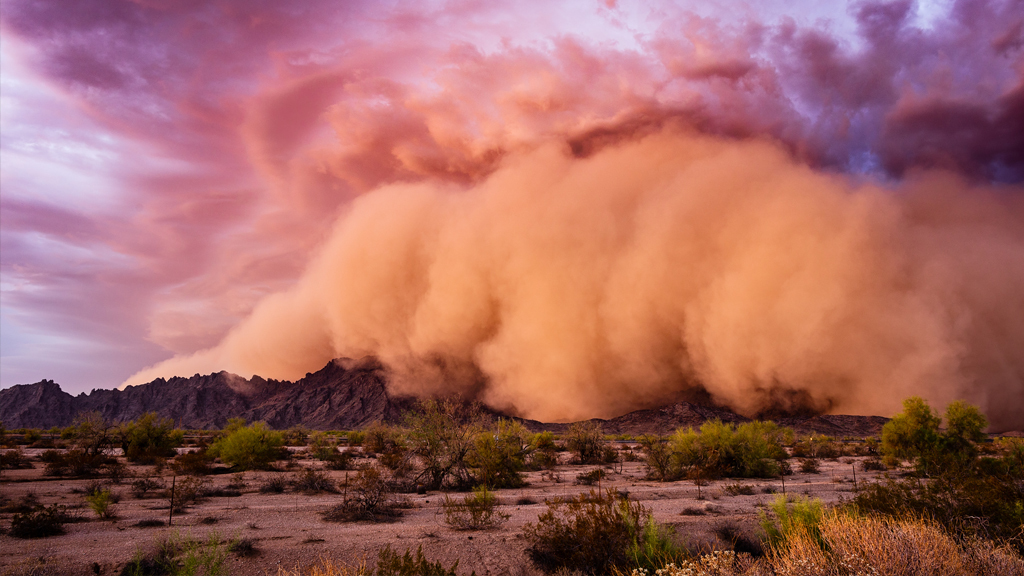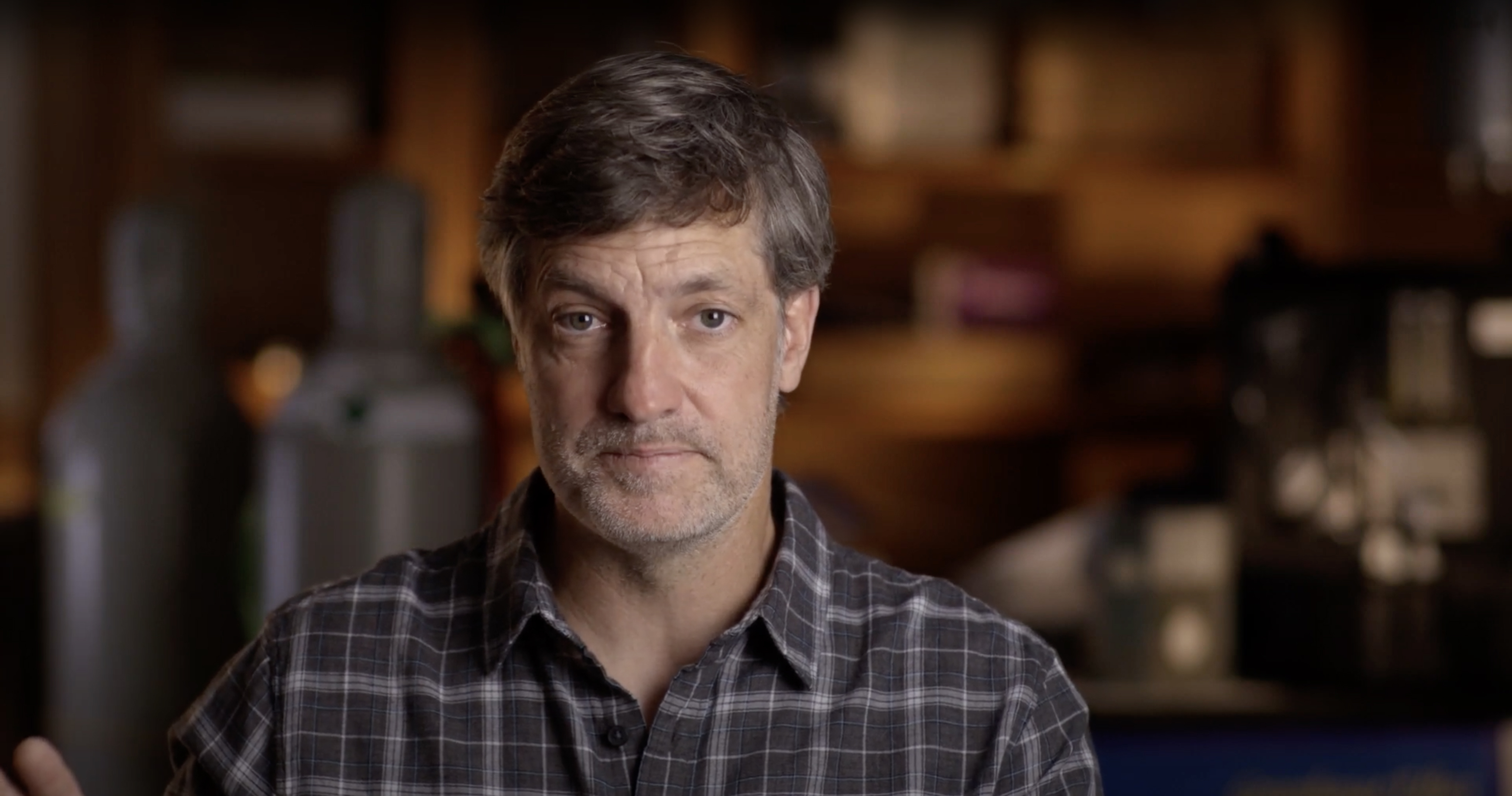Middle School | Daily Do
Why Do Some Cities Currently Have Dust Storms and Others Do Not?

Climate Change Disciplinary Core Ideas Is Lesson Plan Life Science NGSS Phenomena Science and Engineering Practices Three-Dimensional Learning Middle School Grades 6-8
Sensemaking Checklist




Summary
Middle school students, as scientists, investigate wind and vegetation data to answer this driving question: Why do some cities currently have dust storms and others do not? Students are introduced to two cities: one that currently has dust storms and another that doesn't. Students analyze wind map data to investigate the presence or absence of dust storms in the two cities. Noting that the two cities have similar mean wind speeds, students consider why wind data alone is not sufficient to develop a model that predicts dust storms. Next, students use photos of vegetation in the two cities and information from the Our Beautiful Planet: Dust Rising film to construct an explanation of why one city currently has dust storms, and the other doesn't. Finally, students propose ways communities could use dust storm models to keep people safe, and consider how climate change could affect where dust storms happen in the future.
Click the Download PDF button above for the complete Lesson Plan.
Materials and Teacher Preparation
Teacher Materials
- Our Beautiful Planet: Dust Rising film
- Optional—Wind Maps from additional months in 2021 and Wind Speed Anomaly Maps from 1991 to 2020 can be found at the U.S. Wind Climatology website.
Student Materials
Required Student Prior Knowledge
We recommend using this lesson after or near the end of a unit about natural hazards. Students should have an understanding of the following ideas:
- ESS2.D—Weather and Climate
Weather and climate are influenced by interactions involving sunlight, the ocean, the atmosphere, ice, landforms, and living things. These interactions vary with latitude, altitude, and local and regional geography, all of which can affect oceanic and atmospheric flow patterns. (MS-ESS2-6) - Some natural hazards, such as volcanic eruptions and severe weather, are preceded by phenomena that allow for reliable predictions, but others, such as earthquakes, occur suddenly and with no notice, and thus are not yet predictable.
- Examples of data can include the locations, magnitudes, and frequencies of the natural hazards.
- Examples of technologies can be global (such as satellite systems to monitor hurricanes or forest fires) or local (such as building basements in tornado-prone regions or reservoirs to mitigate droughts).
Experience the Phenomenon
Tell students that they will investigate a specific type of natural hazard today: dust storms. Dust storms are currently difficult to predict. To develop models to make predictions about dust storms, scientists are investigating areas that have frequent dust storms.
Tell students that they will evaluate information about two cities in the United States: one that had frequent dust storms in 2021 (El Centro, California) and one that did not (Birmingham, Alabama).
Direct students to page one of the Dust Storms Student Reference Sheet.
Ask students to do the following:
- Note the similarities and differences between the two cities.
- Write down questions they have about the two cities.
After students work independently for a few minutes, ask them to discuss the similarities, differences, and questions they discovered with a partner.
Once pairs have had time to discuss their ideas and questions, lead an initial ideas class discussion. Create a class record of the information shared on a poster, slide, or board.
Similarities and differences students might list are these:
- Both cities have latitudes between 30 and 35.
- Both cities are not located near an ocean.
- Connections to what they previously learned about latitude, proximity to the ocean, and climate. They might note that since the two cities are both at similar latitudes and not near the ocean, they could have similar climates if other factors are the same.
- El Centro, California, has dust storms, and Birmingham, Alabama, does not.
Questions students may share are these:
- What are other differences between the two cities?
- What causes a dust storm?
- What is a dust storm?
- Why do some cities currently have dust storms and others don't?
- Why does El Centro, California, currently have dust storms, and why doesn't Birmingham, Alabama, have them?
- Can the places where dust storms happen change?
Student questions should converge on a question similar to Why do some cities currently have dust storms and others do not? Or Why does El Centro, California, currently have dust storms and why doesn't Birmingham, Alabama, have them? Inform students that they will investigate their question in the next section of the lesson.
Teacher Note—Connecting to Students' Background Knowledge and Prior Experiences
If time allows, consider starting the discussion by making connections to their prior experiences:
- Ask students to think about a type of natural hazard that is common in your area (for example, hurricane, earthquake, tornado, blizzard).
- Is there typically time to prepare for this type of hazard, or does it happen without warning?
- Why is it helpful to be able to prepare for a natural hazard? What have they done in the past to prepare?
Teacher Note—Class Discussions
For more information about different types of class discussions and class discussion facilitation, consult the OpenSciEd resource 3 Discussion Types.
Investigate
Tell students that to begin to answer the question of why dust storms currently happen in El Centro, but not in Birmingham, they will need to start with two other questions raised. The first is What is a dust storm?
Ask students to discuss with a partner what comes to mind when they hear the phrase dust storm. What do they think happens during a dust storm? What do they think causes a dust storm?
S= Discuss with a partner their ideas about dust storms.
T= Circulate and listen for students who are listing lots of dust in the air and fast wind speeds as probable components of a dust storm.
Ask for a few volunteers to share their ideas. Point out that several students listed wind as part of a dust storm.
Inform students that now they will be looking at wind speed data in the United States. This map could provide information that will answer another question raised: What are other differences between the two cities?
Direct students to Page 2 of the Dust Storms Student Reference Sheet and provide a brief overview of the maps.
- The 10 m. in the title of the first map refers to the fact that the wind speed is measured 10 m. above the ground.
- The first map shows the mean (average) wind speed in each state for the month of March 2021.
- The darker the red color, the faster the mean wind speed.
- The second map shows the abbreviations for each state’s name for students’ reference. It also shows the locations of El Centro and Birmingham.
Ask students to consider the following prompts with a partner.
- Find El Centro and Birmingham on the map.
- Is there a difference in their mean wind speeds?
- Fast-moving winds are one of the conditions needed for a dust storm. Based on this data alone, which city would you predict has dust storms: El Centro, Birmingham, or both?
S = Analyze the maps, note if the mean wind speeds for El Centro and Birmingham are similar or different, and make connections to dust storms.
T = Circulate and listen for students who are making a connection between fast wind speeds and dust storms. Also, listen for students who are grappling with how El Centro and Birmingham have similar wind speeds, but not the same number of dust storms. Ask these students to share their ideas with the whole class.
Expected Student Responses—Answers will vary, but students should note the mean wind speeds for both El Centro and Birmingham are in the 4 to 6 meters per second range. Based on this data alone, it would seem like both El Centro and Birmingham could have dust storms, but this is not the case.
Ask students to consider what questions they still have after looking at the wind map data. Give students time to think alone and discuss questions with a partner. Listen for students who are asking about other differences between El Centro and Birmingham or who want additional information about the two cities. Ask these students to share their questions with the class.
Acknowledge that several students asked for additional information about the two cities. Tell students that they will now analyze photographs that show each city’s vegetation (plant life).
Ask students to discuss the following questions with a partner. Students should use the maps as well as the photographs of vegetation in El Centro and Birmingham to help answer the questions.
- El Centro and Birmingham have similar wind speeds, but El Centro currently has dust storms and Birmingham currently doesn’t. What differences between the cities might cause El Centro to have dust storms?
- Based on the data you have, do you think wind speed alone could be used to create a model that predicts when and where dust storms will happen? Why or why not?
Ask for students to share their responses to the questions. Ensure that the following points emerge.
- The pictures of El Centro and Birmingham are very different. El Centro looks like a desert, and there is a lot of dust on the ground. There aren’t any trees in the picture. Birmingham seems to have a lot of trees and grass, which might mean that there is less loose dust on the ground.
- The presence of trees and other plants and how flat or steep the land might also have an effect on how much dust is in the air, which could affect the probability of a dust storm.
- Wind speed alone probably can’t be used to build a model to predict dust storms. Birmingham has similar wind speeds as El Centro, but it currently does not have frequent dust storms.
Tell students that they are now going to watch a film that discusses how scientists are developing a model to predict when and where dust storms will happen. The scientists are working in a desert near El Centro. Project the Our Beautiful Planet: Dust Rising film and play the entire video.
- Students = Write down information that might help explain why El Centro currently has dust storms and Birmingham does not. Discuss with a partner after the film has ended.
- Teacher = After the film has ended, move around the room and encourage students to record any new questions that arise from listening to their partner.
- Listen for students who point out that El Centro’s proximity to the desert and the evaporating lake (Salton Sea) has led to a large amount of dust in El Centro, which combined with high winds leads to dust storms.
- Also listen for students who are making connections to the photo they observed of Birmingham. The area has similar wind speeds as El Centro, but much more plant life. The plants mean there is not as much loose soil and dust, so Birmingham doesn’t currently have dust storms.
- Ask the students to prepare to share their ideas with the class.
Facilitate a whole-class Consensus Discussion. Help students consider alternate explanations and develop a common explanation. You might use the questions below to help facilitate the discussion.
- At the beginning of the lesson, several students asked questions about the differences between El Centro and Birmingham. What information from the film and the Dust Storms Student Reference Sheet could be used to answer their questions?
Expected Student Responses—Answers will vary, but students should point out that the film confirms the differences between the two cities they noticed in the photos. Birmingham has a lot of trees and grass, and El Centro has fewer plants and more loose soil and dust.
- What are the two ingredients of a dust storm discussed in the film? Does El Centro have both ingredients? Does Birmingham?
Expected Student Response—Regarding dust and mid to high wind speeds, El Centro has both ingredients, but Birmingham only has the wind speed component.
Tell students to use the information from the discussion, film, and Dust Storms Student Reference Sheet to write an explanation of why El Centro currently has dust storms and Birmingham does not.
Expected Student Response—For a dust storm to happen, you need wind and dust. Both El Centro and Birmingham have wind speeds between 4–6 meters per second. Only El Centro currently has a lot of dust because there isn’t a lot of grass or trees, and there is a lake that is evaporating nearby. Birmingham has trees and grass that keep more of the soil in place. So only El Centro has dust storms right now.
Teacher Note—Dust Storms
In the film and the lesson, dust and wind are noted as the key ingredients for a dust storm. Additional factors can affect the likelihood of a dust storm happening in a region, such as the geography of the region. Some students might note that El Centro seems flatter than Birmingham. For more information, consult NOAA SciJinks: What Is a Dust Storm?
Reflect
Choose one of these reflection pathways to discuss with students or to discuss first with students: mitigating the risk of dust storms or climate change and dust storms.
Mitigating Risk
- How could a model that predicts dust storms be used by communities to keep people safe?
Facilitate an Initial Ideas Discussion about the reflection question.
Expected Student Response—Answers will vary; ideas presented could include the following:
- Cities could have a siren that warns people when a dust storm is going to happen. People would know to stay inside, and if driving, to pull over to the side of the road.
- People could plan outdoor activities for days when dust storms are not predicted to happen.
- In areas that have a high risk for dust storms, people could build shelters for those who are caught outside during dust storms.
Climate Change
- Do you think climate change could change where dust storms happen in the future? Could Birmingham have dust storms? What data would you need to better answer the question?
Facilitate an Initial Ideas Discussion about the reflection question.
Expected Student Response—Answers will vary; ideas presented could include the following:
- The film said climate change could make places hotter and drier, so there could be more dust in places like Birmingham that currently don’t have dust storms.
- Information about the trees and plants currently in Birmingham: temperatures they can survive in; how much rain they need, etc.
Teacher Note—Formative Assessment Opportunity
Consider asking students to look at the Wind Map data again and make predictions about five other states that currently might have dust storms.
After time to consider the question alone, with a partner, and in class discussion, let students know that according to the National Weather Service, dust storms are most common in the Southwest region of the United States. States with frequent dust storms include Texas, New Mexico, Arizona, Nevada, California, Utah, Oklahoma, and Colorado.
Ask students to look at the wind map again and note any patterns they observe when looking at the states that commonly have dust storms.
Expected Student Response—All of the states that have the most dust storms have monthly mean winds of at least 4 meters per second. Several of them have higher mean winds. All of the states have at least a light orange color. Several have darker orange or red.
Ask students to think about what else these states might have in common if they currently have dust storms.
Expected Student Response—Answers will vary, but students should note that each of these states might have areas that are similar to El Centro in terms of vegetation and availability of dry soil and dust.

Meet Amato Evan
Amato Evan is a professor in the Climate, Atmospheric Sciences, and Physical Oceanography Division of the Scripps Institution of Oceanography. Over the course of his professional career, he has published more than 50 academic papers and technical reports, taught several courses at the graduate and undergraduate level, secured more than $1,000,000 in extramural support, and collaborated with more than 50 scientists from North America, South America, Europe, Africa, and Asia. Evan’s work has been reported on by major news organizations around the globe, and he has conducted more than 50 interviews with print, radio, and television media outlets. Besides his work in academia, Evan has also served as a consultant to the private sector, including in reinsurance, risk management, and finance.
About the Our Beautiful Planet Film Series
This lesson is based on information provided in Our Beautiful Planet: Dust Rising. Our Beautiful Planet is a fascinating new series highlighting the work that climate scientists around the country are doing to solve some of the world’s most pressing issues. These dedicated scientists are seeking to better understand and plan for the realities of our changing climate. Using cutting- edge technology and innovative problem solving, their answers are sometimes found in rather surprising and unexpected places. This series transports the viewer to some of the most important field work being done today, taking the science out of the classroom and into the world. These compelling stories will not only teach viewers crucial scientific principles, but also will inspire them to use science to examine the issues their own communities face in this changing world and climate. Through these films, the producers hope scientists and citizens alike can come together to safeguard our environment and to protect our beautiful planet. Productions by Kikim Media. Support provided by Kennebunkport Climate Initiative.




